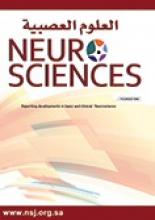Abstract
The pathoanatomical explanation of lumbar disc herniation causing the rare cauda equina syndrome with sacral 2- sacral 4 roots sparing is not well described. A case report of bladder sparing cauda equina syndrome due to a large posteriorly sequestered lumbar disc fragment is presented. Magnetic resonance imaging of the lumbosacral spine showed herniation of a large disc fragment at lumbar 3-lumbar 4 deforming the thecal sac posteriorly, with the left side more affected than the right. Bladder sparing cauda equina syndrome can be explained by the anatomical organization of the nerve roots within the thecal sac. The medial sacral roots are not as stretched and strained by the herniating disc as the laterally placed lumbar roots. Early laminectomy and decompression of the thecal sac may relieve this stretch and strain on the nerve roots and therefore preserve bladder function.
- Copyright: © Neurosciences
Neurosciences is an Open Access journal and articles published are distributed under the terms of the Creative Commons Attribution-NonCommercial License (CC BY-NC). Readers may copy, distribute, and display the work for non-commercial purposes with the proper citation of the original work.






